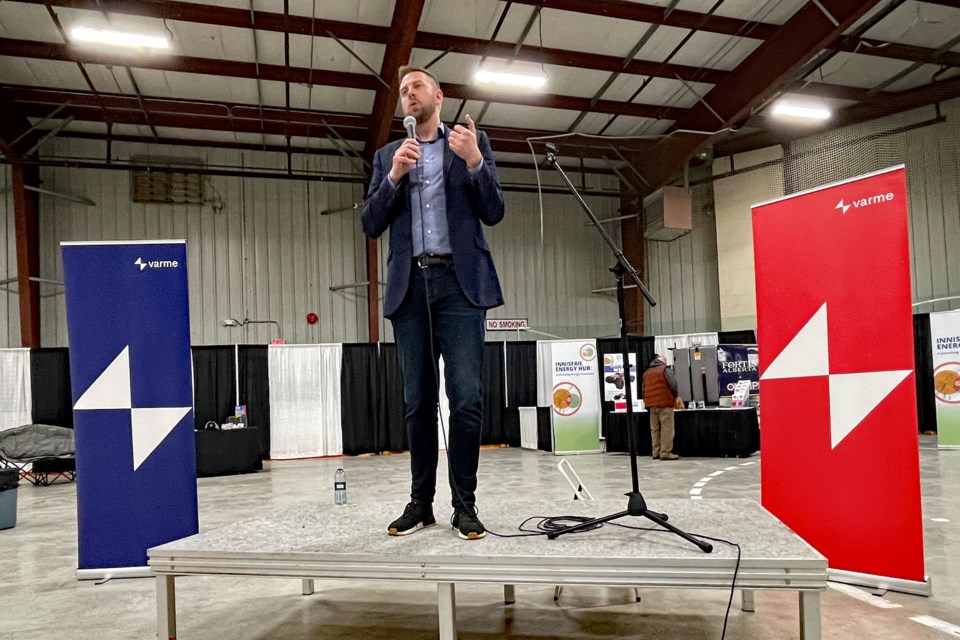INNISFAIL – In past years, the red rink at the Innisfail Twin Arena for the annual Innisfail & District Spring Trade Show was usually set aside for secondary attractions.
Not so in 2023.
Developed by the Innisfail Energy Hub for both March 31 and April 1, the red rink was the focus area for highly anticipated presentations under a Future of Energy theme.
Scores of attendees came to hear what the best and brightest had to say about the growing business interest for energy transition.
“I've really pleased to see how much traffic we've had for the presentations,” said Blaine Staples, president of the Innisfail & District Chamber of Commerce, the sponsor of the annual event. “I think next year we're going to come back bigger and better.
“Our vision was to have a bunch of vendors in the alternative energy space but we didn't have a lot of time to get that lined up,” he added. “We can start working on lining up some of those vendors and planning for that on Monday. We'd like to see that other arena become a real showcase for alternative energy.”
Nevertheless, the list of presentations this year was impressive.
Sean Collins, chief executive officer of Varme Energy, opened with his pitch on Friday night (March 31) and delivered an update on his company’s massive $200 million plan to create a waste to energy facility in Innisfail; a project his parent Norwegian company is now experiencing huge success in Europe; both economically and for the environment.
Following his presentation Collins faced many questions, and some concerns, including light pollution, setbacks, truck traffic and the proposed plant’s close proximity to the centre of town.
He addressed each one; pointing out the environmental benefits of the new technology, as well as his company’s enviable safety record. He also highlighted the economic benefits it would bring to the Innisfail and area community.
“A project like ours for the Town of Innisfail would be massively profitable. We'd be the largest industrial investment in Innisfail history,” Collins told attendees.
He said annual tax revenue for the town would be in the “ball park” of about $1.5 to $2 million.
Following his presentation Collins said he was pleased to attend the trade show, noting there was at least 50 or more who dropped by to hear his pitch and to address any and all types of questions.
“You don't want to be blindsided by anything in the community and we don't want to blindside the community, and so we really appreciate the opportunity,” said Collins. “I'm sure we'll do this four, five, six, seven, eight, nine times before we get this thing built, so we really appreciate it.”
The following day (April 1) there were several other presentations, including ones from FortisAlberta, Red Deer Polytechnic and Alberta Municipalities.
But it was Robert Bilton, president and chief executive officer of Bilton Welding and Manufacturing Ltd., who took centre stage to talk to Innisfailians face-to-face for the first time about his company’s recent announcement it has partnered with Canadian Pacific (CP) to create and build hydrogen-powered locomotives.
It’s an endeavour that could soon see revolutionary clean and green changes with the way tens of thousands of trains criss-cross the continent to deliver goods.
“We got responses from all over North America. We got responses from Europe as well. Everything was positive,” Bilton told the Albertan after his presentation. “I think the people that were responding were all like-minded and are hoping to see a progression in clean technology being developed here and elsewhere in the world.”
Added with the four train engines now successfully converted at his Innisfail plant, the interest for many more has already begun.
“I'm working very hard on a larger long-term contract with CP to take more bulk orders like 10 at a time. We're hoping that will be resolved in the not-too-distant future. I'm talking weeks, not months,” Bilton told his audience, adding an American rail company is looking at another 10 units.
“If we all truly believe that we've got to stop burning hydrocarbons in the manner that we're doing it will happen quite quickly. I can't make it happen by myself,” said Bilton, noting the project will also have huge benefits for the community. “For every engine we convert there's about $600,000 of wages going into the community. So ten would be six million. Twenty would be 12. A hundred would be 60.
“It's good opportunity. These are good jobs that are safe and well paid,” added Bilton. “These aren't digging coal out of a mine. They are really, really good opportunities for young people.”



